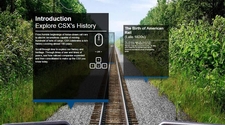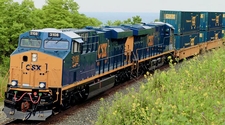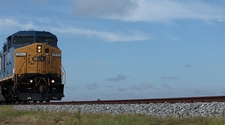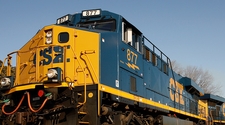| Easy Sign |
A hand signal indicating the train is to move slowly. |
| Eave |
The projecting edge (overhang) of the roof on a rail car. |
| EDI |
Electronic Data Interchange, either with computers, FAX machines or telephones. Used to make and trace car orders, issue bills of lading, electronic payment transfer, etc. |
| Electric Lock |
An electrical locking device applied to a hand-operated switch, derail, or gate. |
| Electric Locomotive |
A locomotive which receives electric power from an overhead contact wire or third rail and uses the power to drive electric motors connected by gears to the driving axles. |
| Electrically Locked Switch |
A hand-operated switch equipped with an electrically controlled device which restricts the movement of the switch. |
| Electronic Air Brake (EAB) |
Locomotive brake equipment mounted on the control stand, which has the same movements and positions as the 26C and 30A automatic brake valves. This equipment provides microprocessor electropneumatic control for the brakes on locomotives and cars. |
| Elkins Act |
Law providing penalties for violation of the Interstate Commerce Act. |
| Embargo |
An order prohibiting the acceptance and/or handling of freight at certain points or via certain routes due to emergencies, congestion, strikes, etc. |
| Emergency Brake Application |
A quick, heavy reduction of brake pipe pressure, which will cause the control valves to assume an "emergency position" and serially propagate the emergency brake application throughout the train. |
| Emergency Brake Valve |
A valve located in the locomotive cab, in addition to the automatic brake valve, which will cause an emergency brake application when opened. |
| Emergency Rate |
A rate, generally short-term, established to meet some immediate and pressing need, without due regard to the usual rate considerations. |
| Emergency Reservoir |
A storage volume for compressed air, charged from the brake pipe, to provide air pressure for use in emergency brake applications and certain recharge features. An emergency reservoir is located on each car, contained in the same structure as the auxiliary reservoir. |
| Empty Car |
Freight car without a load. |
| Empty Car Bill (Slip Bill) |
Waybill used to move ordinary empty cars from one station to another. |
| En Route Movement Instructions (Form ER) |
A form used to record specified instructions regarding train movement. |
| End Door |
A door in the end of a car. In some box cars this door is used for loading and unloading long material which cannot be handled through the side door. |
| End of Train Device (EOT) |
A portable sensory transmitter unit mounted on the last car of a train that transmits information to a receiver display unit on the engine. |
| Engine |
A locomotive unit propelled by any form of energy. It is also a combination of such units operated from a single control. |
| Engineer |
The operator of a locomotive. |
| Equalizing Reservoir |
A small reservoir, which is connected to an equalizing piston or diaphragm chamber for use in automatic air brake applications. |
| Equipment Initial and Number |
Identifying information stenciled on transportation equipment. See Car Initial and Number. |
| Equipment Pools
|
Established to facilitate car supply and prevent contamination of the shipper's product. There are three basic types of pools: Agency Pools: Cars in an agency pool are assigned to a local agent and are returned empty to that agent when unloaded at the ultimate destination. Car Management Pools: Cars are assigned for service to a particular commodity, industry, or location by Car Management to fill car orders. Customer Pools: Cars in a customer pool are reserved for loading by a specified shipper only.
|
| Equipment Register |
Manual of physical descriptions of cars owned by the railroads, government, and other industries. |
| ERPC |
Eastern Railroad Presidents' Council. |
| Estimated Weight |
The weight specifically stated in tariffs for goods shipped in certain packages or in a certain manner. The weight used in lieu of actual weight at origin. Agent can use the shipper's weight, the marked capacity of the car, the tariff or minimum weight until the actual scale weight has been established en route or at destination. |
| Ex Parte |
On one side or from one side only. Usually associated with an increase in freight rates. |
| Ex Parte Level |
See Increase Level. |
| Excepted Track |
A segment of track that is identified in special instructions, where: No train shall be operated at speeds more than 10 MPH. No revenue passenger train shall be operated. No freight train shall be operated that contains more than five cars required to be placarded by the Hazardous Materials Regulations (49 CFR). |
| Exceptions to Classification |
A publication containing classification ratings and rules different from the Uniform Freight Classification ratings and rules. |
| Excess Prepay |
Amount in the prepaid column which exceeds the total of the freight plus advances. |
| Excessive Dimension |
See High-Wide. |
| Exchange Bill of Lading |
A bill of lading issued in exchange for another bill of lading. |
| Exclusive Authority to Move |
The authority the train has to occupy a track does not include other movement within the same limit. |
| Execution Chain |
A list of transactions that will be used to create or update a waybill. This list is built internally from one of the major data entry screens, and it is stored on the on-line Session Control (AWSDAP) database. |
| Expense Bill |
See Freight Bill. |
| Expiration Notice |
A notice in a tariff that all or some part of it will expire at a stated time. |
| Export |
To send goods to any foreign country. |
| Export Bill of Lading |
A bill of lading that covers shipments to a foreign country. |
| Export Rate |
A freight rate specially established for application on export traffic and generally lower than the corresponding domestic rate. Rates designated as export or import generally take precedence over domestic rates on the same shipment. |
| Extension Error |
Charges on a waybill which are added, subtracted, or multiplied incorrectly or placed in the wrong column, or omitted altogether. |
| Extra Board |
A list of employees who may be assigned to train crews (1) when extra trains are run, (2) when regular crews have not had sufficient rest time before they can legally be required to return to duty, or (3) when relief men are required on regular crews. |
| Extra Train |
A train not authorized by a timetable schedule. It may be designated as: Extra: for any extra train, except work extra. OR Passenger extra: for any extra train authorized by train order. |
| back to top |

















